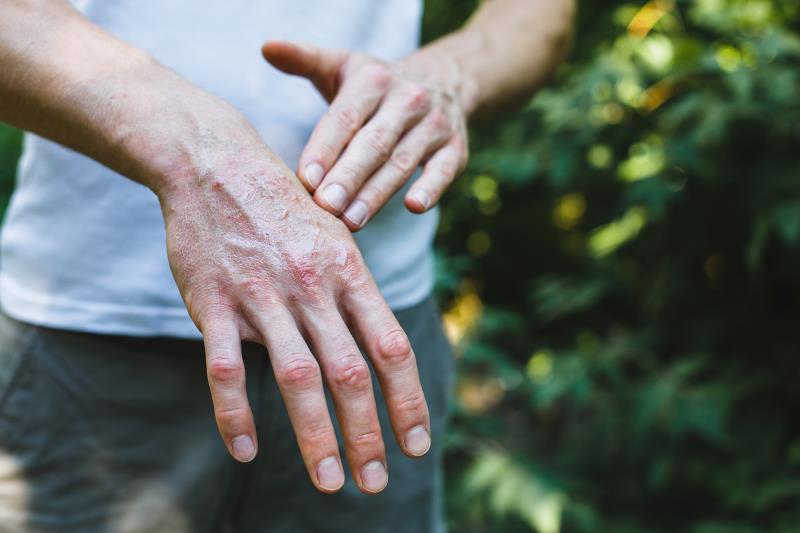Apremilast delivers favourable outcomes for patients with early oligoarticular PsA





In the treatment of patients with early oligoarticular psoriatic arthritis (PsA), the use of apremilast yields substantial improvements in both clinical and patient-reported outcomes, as shown in the results of the phase IV FOREMOST study.
After 16 weeks of treatment, significantly more patients in the apremilast arm than in the placebo arm achieved the primary endpoint of minimal disease activity (MDA)-Joints response* based on sentinel joints (33.9 percent vs 16.0 percent; p=0.0008). [Ann Rheum Dis 2024;doi:10.1136/ard-2024-225833]
Results for other secondary outcomes also favoured apremilast over placebo. Clinical Disease Activity in Psoriatic Arthritis (cDAPSA) remission or low disease activity (LDA) was achieved by 70.2 percent of patients treated with apremilast vs 51.8 percent of those on placebo (p=0.0017), while tender joint count of ≤1 was documented in 66.2 percent vs 44.4 percent (p=0.0003), respectively. No significant difference was observed in the proportion of patients who achieved swollen joint count of ≤1 (74.0 percent vs 69.0 percent; p=0.35).
As for patient-reported outcomes, those on apremilast than on placebo were more likely to achieve Patient Global Assessment of Disease Activity (PtGA) ≤20 mm on a 100-mm scale (30.4 percent vs 19.1 percent), low pain levels (29.4 percent vs 13.1 percent), and decreases in Psoriatic Arthritis Impact of Disease (PsAID-12; –1.5 vs –0.4). More patients in the apremilast arm had a good or moderate response in Psoriatic Arthritis Disease Activity Score (PASDAS) (59.9 percent vs 42.7 percent).
“When evaluating all joints, overall response rates were lower than those observed with sentinel joints but still significantly greater with apremilast than with placebo. These results may reflect a recently diagnosed population whose disease presentation is still evolving, as well as the waxing and waning course of the disease,” the investigators said.
Highly prevalent in clinical practice, oligoarticular PsA is present in up to 50 percent of patients in certain cohorts. It is the most frequent clinical pattern reported in early disease and has been shown to be a less erosive form of PsA. FOREMOST, according to the investigators, illustrates the risk of undertreatment for progression from oligoarticular to polyarticular disease and argues for earlier and more proactive intervention for oligoarthritis, in line with the EULAR recommendations. [J Rheumatol 2021;48:1824-1829; RMD Open 2023;9:e003143; Ann Rheum Dis 2020;79:700-712]
“FOREMOST is, to our knowledge, the first large, randomized, placebo-controlled trial only enrolling patients with oligoarticular PsA and provides valuable information on how patients with early disease and limited joint involvement respond to apremilast treatment,” they added.
A total of 308 patients (mean age 50.9 years, 54.9 percent female, 94.5 percent White) with early (symptom duration ≤5 years) oligoarticular PsA (>1 but ≤4 swollen and >1 but ≤4 tender joints; 2–8 total active joints) participated in FOREMOST. These patients were randomly assigned to receive apremilast 30 mg two times per day (n=203) or placebo (n=105) for 24 weeks, with an early escape at week 16, where patients who initially received placebo were switched to apremilast 30 mg two times per day and those who initially received apremilast continued treatment at the same dose.
The mean PsA duration of the cohort was 9.9 months, and 39.9 percent of patients were using a conventional synthetic disease-modifying antirheumatic drug, mostly methotrexate (107/123). Mean swollen and tender joint counts at baseline were 2.6 and 3.2, respectively. Small joints were commonly affected, and nearly 90 percent patients had ≤4 active joints at baseline.
Treatment-emergent adverse events (TEAEs) were reported in 59.3 percent of patients on apremilast and in 47.1 percent of those on placebo. Diarrhoea was the most frequently reported TEAE (23.0 percent vs 10.6 percent), followed by nausea (10.8 percent vs 3.8 percent) and headache (7.8 percent vs 2.9 percent). No significant between-group differences in the incidence of severe TEAEs (3.9 percent vs 3.8 percent) and serious TEAEs (4.4 percent vs 5.8 percent) were observed.
Meanwhile, the apremilast arm had greater proportions of patients with TEAEs leading to drug interruption (7.8 percent vs 2.9 percent) or drug withdrawal (10.3 percent vs 6.7 percent). One patient in each arm died during the study, but none of the deaths were related to the study drug.
*Modification of MDA mandating ≤1 swollen joint and ≤1 tender joint